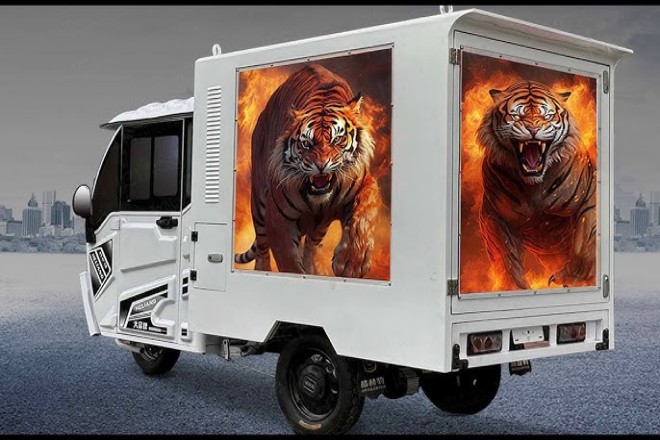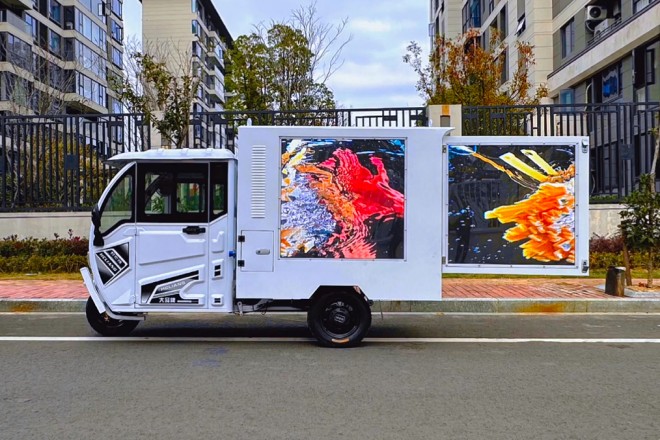序章

あなたもクールに見えると思ったことはありませんか? LEDディスプレイ 通りや路地を行き来する三輪トラックにスクリーンを設置してみませんか? これらのスクリーンは、情報発信を活発かつ興味深いものにするだけでなく、商業プロモーションや公共サービスなどに新しい方法をもたらします。
では、三輪トラックは本当にモバイル LED ディスプレイの運搬車になることができるのでしょうか? この記事では、テクノロジー、コスト、規制などを調べ、あらゆる側面からこのアイデアの実現可能性を分析します。
1. 移動式トラックのLEDディスプレイの簡単な紹介

要するに、 移動式トラックの LED ディスプレイ 先進的なLEDディスプレイ技術とモバイル通信技術を統合した屋外広告・情報公開プラットフォームです。
通常は大型トラックやトラックなどの移動式運搬車に搭載され、LEDランプアレイで構成された高解像度スクリーンを使用して、動的な画像、動画、テキストを表示します。
一般的には以下のような場面で使われます。
- 情報発信:
移動式トラックのLEDディスプレイは、都市情報の「移動窓」として、さまざまな社会ニュース、政府発表、緊急通知などを瞬時に広く発信し、人々の情報入手能力を高めます。
たとえば、米国の選挙では、両候補者とも、影響力をさらに拡大することを望んで、さまざまな州で演説を行う際に、移動式トラックの LED ディスプレイを移動放送に好んで使用しました。
- 広告:
モバイル トラック LED ディスプレイのダイナミックで目を引く表示効果は、ブランドのプロモーション、製品の発売、イベントの告知に最適です。
移動式トラックの LED ディスプレイは移動式の販促装置であるため、ブランド認知度と市場影響力を効果的に高めることができるため、非常に人気があります。
例えば、コンサートなどの大規模イベントの推進力となる。 スポーツ イベントや映画のプレミア上映などを通じて、事前に一般の関心を喚起し、現地での参加を促します。
- 緊急対応:
自然災害や公共安全事故などの緊急事態では、移動式トラックの LED ディスプレイを緊急情報伝達ツールに素早く変換し、早期警告情報や避難指示などを提供して、緊急対応を支援します。
たとえば、大雨や高温などの天候の変化やその他の早期警告情報をタイムリーに発表することで、一般の人々に予防策を講じるよう促すことができます。また、休日や学校周辺では、安全な旅行、火災予防、盗難防止などの公共広告を流して、公共の安全意識を高めることができます。
2. 三輪トラックへの移動式LEDスクリーン設置の実現可能性分析
1). 技術的な考慮事項
1.1) LEDスクリーンの選択
三輪トラックに LED スクリーンを設置する場合、まず考慮すべきことはスクリーンのサイズと重量です。
スクリーンが大きすぎると三輪トラックへの負担が大きくなるだけでなく、運転の安全性にも影響する可能性があります。そのため、軽量でありながら宣伝ニーズを満たすことができるスクリーンを選択する必要があります。
同時に、画面の表示効果も非常に重要であり、次のようなパラメータが含まれます。 解決, 輝度 コントラストは視聴者の視聴体験に直接影響します。
1.2) 設置場所の決定
設置場所の選択は慎重に行う必要があり、スクリーンが観客の注意を引き付けると同時に、運転手の視線を遮ったり、三輪トラックの正常な運転に影響を与えたりしないようにする必要があります。
ディスプレイ画面を車の側面または後部に設置することを選択できます。目立つだけでなく、運転の安全性にも影響しません。
1.3) 電源および信号ラインの処理
ディスプレイ画面には安定した電源と信号伝送が必要ですので、設置時には、運転中の振動や摩擦による緩みや損傷を防ぐために、電源線と信号線がしっかりと確実に接続されていることを確認する必要があります。
同時に、外部環境による損傷からラインを保護するために、防水性、防塵性、耐摩耗性のケーブルジャケットを使用するなど、追加の保護対策を講じることもできます。
2) 経済分析
2.1) コスト比較
LED ディスプレイ スクリーンの設置を検討する前に、ディスプレイ スクリーンのコストと三輪トラックの価値を比較する必要があります。ディスプレイ スクリーンのコストが高すぎて、三輪トラックの価値が比較的低い場合、ディスプレイ スクリーンを設置しても費用対効果が得られない可能性があります。
したがって、投資が妥当な利益を得られるよう、ディスプレイ画面の費用対効果と長期的なメリットを総合的に考慮する必要があります。
2.2) 運用上の利点とコスト
LEDディスプレイを設置すると、広告収入による運用上のメリットが得られますが、運用コストを無視できるわけではありません。
運用コストには、ディスプレイ画面のエネルギー消費コスト、メンテナンスコスト、承認およびライセンス料などが含まれます。プロジェクトの収益性を確保するには、これらのコストを詳細に計算して分析する必要があります。
3). 規制および基準の遵守
3.1) 変更計画の遵守
改造する前に、関連する交通規制や基準を理解し、遵守する必要があります。これには、車両安全基準、環境保護基準、交通管理部門の承認要件が含まれます。
変更計画がこれらの基準と要件を満たしていることを確認できた場合にのみ、変更作業を実行できますか?
3.2) 必要な承認と許可
変更前には、変更計画を交通管理部門に提出する必要があり、承認と許可を得た後にのみ変更を実行できます。
変更プロセス中は、変更作業の合法性と安全性を確保するために、関連する規制と標準を厳密に遵守する必要があります。
改造が完了したら、改造された三輪トラックが関連する基準と要件を満たしていることを確認するために、車両検査と受入も実施する必要があります。
3.三輪トラックにLEDスクリーンを設置するときは、次の点に注意してください
1). ボディサイズと耐荷重
三輪トラックは、ご存知のとおり、小型で狭い路地でも自由に行き来できます。しかし、大型の LED スクリーンを設置する場合は、車体サイズと耐荷重を考慮する必要があります。スクリーンは大きすぎたり重すぎたりしてはいけません。
そうしないと、運転中に車が不安定になり、車が押しつぶされる可能性もあります。したがって、適切なサイズのスクリーンを選択し、車が安定して運ぶことができることを確認する必要があります。
2). パワーと安定性
三輪トラックには、石油を燃料とするものと、電気を燃料とするものがあります。燃料車は十分なパワーがあり、長距離を走行できます。電気自動車は環境に優しいですが、頻繁に充電する必要があります。車種に関係なく、安定した運転が重要です。
スクリーンを車両に取り付けた後、高速走行時や路面の凹凸により車が揺れ、視界に影響を及ぼし、安全上の問題を引き起こす可能性があります。そのため、運転中に車が安定していること、スクリーンがしっかりと固定されていることを確認する必要があります。
3). 規制と安全性
改造車両は交通規制を遵守する必要があり、三輪トラックも例外ではありません。LEDスクリーンを設置する場合は、まず交通管理部門に許可をもらう必要があり、改造車両が安全基準を満たしているかどうかも確認する必要があります。
4正確な測定と位置決め
サイズ合わせ: サイズの不一致による設置の困難や不良な結果を避けるために、購入した LED ディスプレイのサイズが三輪トラックの設置位置と一致していることを確認してください。
正確な位置決め: 取り付け前に、測定ツールを使用してディスプレイの取り付け位置を正確に測定し、ディスプレイが正しく取り付けられ、運転者の視界を妨げないことを確認してください。
5固定と接続
しっかりと固定する: 運転中にディスプレイが揺れたり外れたりしないように、高品質の固定具(ボルト、ナットなど)を使用してディスプレイを三輪トラックにしっかりと固定します。
ケーブル管理: 電源ケーブルや信号ケーブルを接続するときは、運転中にケーブルが緩んだり損傷したりして誤動作しないように、ケーブルが車体にきちんと整然と固定されていることを確認してください。
6防塵・防湿
シーリング処理: ディスプレイ画面にほこりや湿気が入り込み、耐用年数や表示効果に影響が出ないように、ディスプレイ画面の設置場所の周囲を密閉します。
定期点検: ディスプレイ画面の防塵・防湿対策が有効かどうかを定期的に確認し、必要に応じて適時に交換または修理してください。
7メンテナンスとケア
定期的な清掃: ディスプレイ画面を定期的に清掃して表面を清潔に保ち、表示効果と耐用年数を向上させます。
固定具を確認してください: ディスプレイ画面の固定具が緩んでいたり破損していないかを定期的に確認してください。異常がある場合は、すぐに交換または修理してください。
なお、三輪トラックに LED ディスプレイ スクリーンを取り付けるのは、実際にはかなり技術的なテストであるため、専門家でない場合は、専門家に設置してもらい、安全性に注意することをお勧めします。
結論
一般的に、三輪トラックに移動式 LED ディスプレイを設置するというアイデアは非常にクールで実現可能です。
適切に設計・管理されれば、三輪トラックは都市の情報伝達手段として活用でき、企業や公共サービス機関に多様な選択肢を提供することができます。
最後に、LEDディスプレイについてもっと知りたい方は、 ご連絡ください。
